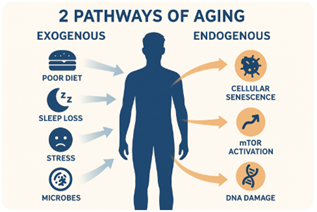The Longevity Equation: How Inflammation Drives Aging — and What You Can Do to Slow It
Longevity isn’t just about living longer — it’s about living better. True longevity means extending the number of years we enjoy vibrant health, sharp cognition, and physical vitality. In recent years, scientists have uncovered compelling links between aging, chronic disease, and a silent internal force at work beneath the surface: chronic inflammation.
This chronic, low-grade inflammation — now widely referred to as “inflammaging” — has emerged as a central mechanism behind the breakdown of three key body systems over time: the immune, nervous, and endocrine systems. When these systems become dysregulated, we see the onset of chronic disease, cognitive decline, and functional impairment.
The Two Pathways of Inflammaging: External Stress vs. Internal Decay:
 1. Exogenous (Oxidative) Stress – Shortening Your Healthspan
1. Exogenous (Oxidative) Stress – Shortening Your Healthspan
This “outside-in” stress originates from lifestyle and environmental exposures that disrupt cellular function triggering the excessive production of reactive oxygen species (ROS) — unstable, pro-inflammatory molecules that damage DNA, proteins, and cell membranes. Although oxidative stress is a normal part of metabolism — even beginning at conception — sustained or excessive exposure accelerates biological aging and raises disease risk.
This pathway is a major driver of what researchers call healthspan — the number of years a person lives in good health, free from chronic illness and physical decline. When oxidative stress is unchecked, it can dramatically shorten this window of vitality.
Common contributors include:
- Poor nutrition (especially processed foods)
- Chronic sleep deprivation
- Environmental toxins like mold, heavy metals, or pesticides
- Emotional or psychological stress
- Gut microbiome imbalances
- Endogenous aging
While oxidative stress is a normal part of life — beginning even at conception — it's the accelerated or sustained exposure that leads to premature aging and chronic disease.
The powerful tools we have to combat the damaging effects of this pathway are:
- Pre and pro-biotics
- Adaptogen supplements
- Antioxidant supplements
- Tissue sulfation
- Cellular energetics
2. Endogenous (Metabolic) Stress – Shortening Your Lifespan
This “inside-out” form of stress stems from internal metabolic dysfunction and biological wear-and-tear, which progress independently of lifestyle choices. Research shows that starting as early as age 23, our cells begin ticking down on an internal biological clock, regulated by telomere shortening, DNA methylation patterns, mitochondrial decay, and epigenetic drift. Unlike oxidative stress, which we can see and feel, metabolic aging is often silent — until it’s not.
Markers of accelerated internal aging include:
- Cellular senescence (zombie cells that no longer function properly)
- Overactivation of mTOR (mechanistic target of rapamycin)
- Declining immune surveillance (weakened immune "authority")
- Genetic clock activation
In response, researchers have identified a growing toolkit of interventions that may not only slow aging — but, in some cases, help reverse key hallmarks of cellular decline.
These include:
- Rejuvenins – emerging nutrients that restore mitochondrial health, improve DNA repair, and enhance cell resilience.
- Pre and Probiotics
- Anti-Reductant Supplements
- Tissue Sulfation
- Cellular Energetics
The Big Question: Can We Reverse Aging?
While the science is still developing, the data is compelling: healthy aging is not just about good genes — it’s about minimizing chronic inflammation, optimizing metabolic function, and supporting your body’s natural repair systems. Can we reverse aging? While science hasn’t found a cure for time, a growing body of evidence suggests we can slow — and even partially reverse — the biological mechanisms that drive aging.
At Sparling Chiropractic, we integrate these science-backed strategies into a holistic care model — addressing not just pain and recovery, but the deeper foundations of long-term vitality. Through personalized chiropractic care, nutrition, and lifestyle interventions, we help patients align their bodies for health that lasts.
Want to learn how your body is aging — and how to slow it down?
Schedule a consultation with Dr. Sparling to explore personalized chiropractic and functional strategies for vibrant aging and lifelong vitality.
References and Resources:
- Franceschi, C., et al. “Inflammaging and anti-inflammaging: A systemic perspective on aging and longevity.” Immunity & Ageing (2018).
- López-Otín, C., et al. “The Hallmarks of Aging.” Cell (2013).
- Kennedy, B. K., et al. “Geroscience: Linking aging to chronic disease.” Cell (2014).
- Sinclair, D. “Lifespan: Why We Age—and Why We Don't Have To.” (Book)
- PubMed: [Search "senolytics" or "rejuvenation nutrition"]
- Lu, A.T., et al. “DNA methylation GrimAge strongly predicts lifespan and healthspan.” Aging (Albany NY) (2019).
- Campisi, J. “Aging, cellular senescence, and cancer.” Annual Review of Physiology (2013).
- Blagosklonny, M.V. “Aging is not programmed: Genetic pseudo-program is a shadow of development.” Cell Cycle (2013).
By Dr. Sparling
‹ Back









